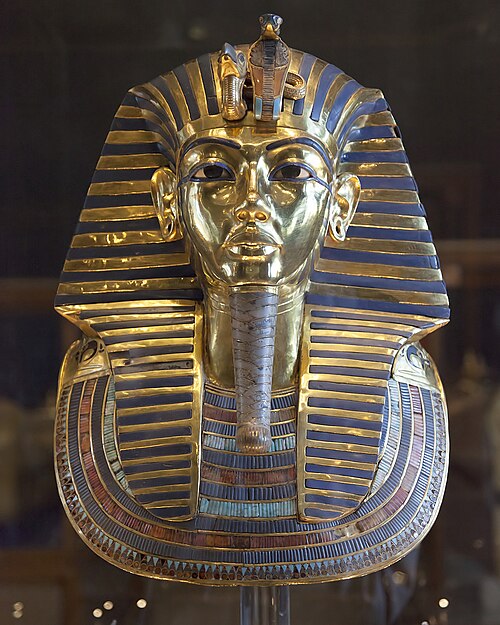
Who was Tutankhamun? Tutankhamun was an Egyptian pharaoh who lived from 1341 BC until 1323 BC. He was only 19 years old when he died. He was pharaoh for nine years, from 1332 BC until he died in 1323 BC. He is probably the most well known of all the Egyptian pharaohs because of his tomb, which was found by Howard Carter in 1922.
As an Egyptian pharaoh, Tutankhamun was fairly unimportant. He was very young when he became pharaoh and he wasn’t pharaoh long enough to have had much of an impact on Egypt. He probably wasn’t very healthy and he was mostly controlled by his main advisor, Ay, who became pharaoh after Tutankhamun died. He didn’t leave many monuments or have any real effect on Egyptian society. If his tomb hadn’t been found in 1922, he would most likely be a footnote in Egyptian history and not a name that everyone knows. Far more is known about him after death than before. Here is a summary of what is known.
Tutankhamun was born in 1341 BC and he was he son of Akhenaten, although this is not completely provable. It is likely, but there is no real evidence. Akhenaten was pharaoh for about 17 years and one of the major things he did in his reign was to move the capital of Egypt to Amarna, which is on the east bank of the Nile and about 312 km south of Cairo. He also turned away from all of the Egyptian gods and started worshiping Aten, who had been a minor god. People did not like this change. Unlike when Emperor Constantine turned the Roman Empire to Christianity, there weren’t enough followers of the new religion in the country to make it stick, and one of Tutankhamun’s first acts was to undo all that his father did. He switched everything back to the way it was. The royal court returned to Memphis and abandoned Amarna. Although, it probably wasn’t him because he was far too young. It was most likely policy carried out by his advisors. Other than that, not a lot was done during his reign. Diplomatic relations were restored with some kingdoms, and there were battles with some other kingdoms, but there is doubt over how much Tutankhamun was involved with any of it. And then, at a very young age, he died.
How he died is unknown. It could have been from illness. It could have been murder. It could have been an accident. There is evidence that he had a clubbed foot and a walking cane was found in his tomb. He might have had other bone disorders that finished him off. He might have had malaria, which was probably fairly common at the time. There is a fracture in his skull, which fueled the murder theory, but that was most likely caused when people unwrapped the mummy. It could have been an accident. Tutankhamun had a broken leg and part of his chest wall and ribs were missing. There is a theory that he was fatally injured in a chariot accident, which led to these injuries. However, photographs from the original excavation show that the chest was there, so it must also have been damaged in the unwrapping.
If it wasn’t for his tomb, most of us would never have heard of Tutankhamun. His tomb was opened on the 4th of November, 1922, by the Egyptologist Howard Carter. Tutankhamun had been interned in there for 3,245 years, untouched. The tomb was found partly by luck. Most of the tombs in the Valley of the Kings had been opened long before Europeans went there. They had been looted for their treasures over the centuries. Tutankhamun’s tomb had also been looted shortly after he was buried, but it had been refilled and sealed. Tutankhamun’s tomb was saved because rubble from the construction of other tombs covered up its entrance and kept it hidden. When I say “saved”, it obviously wasn’t because Howard Carter found it in the end, but the treasures were preserved and not melted down. The tomb was found by luck because Egyptians working for Carter were digging through rubble and they found a step. The step was the first of a staircase that led up to the tomb. When they opened the tomb, they found it full of artifacts and treasures that provided a view of ancient Egypt. It was a wonderful find. There were thousands of artifacts, plus the sarcophagus of Tutankhamun. The mask of Tutankhamun, the image I have used for this article, is probably the most well known image of Egypt after the Pyramids and the Sphinx. All because rubble happened to hide the entrance to a relatively unknown pharaoh’s tomb. And this is what I learned today.
Sources
https://en.wikipedia.org/wiki/Tutankhamun
https://en.wikipedia.org/wiki/Discovery_of_the_tomb_of_Tutankhamun
https://www.pbs.org/articles/king-tutankhamun-life-death-family
https://www.nationalgeographic.com/history/article/king-tutankhamun
https://en.wikipedia.org/wiki/Amarna
Image By Roland Unger – Own work, Public Domain, https://commons.wikimedia.org/w/index.php?curid=48168958
